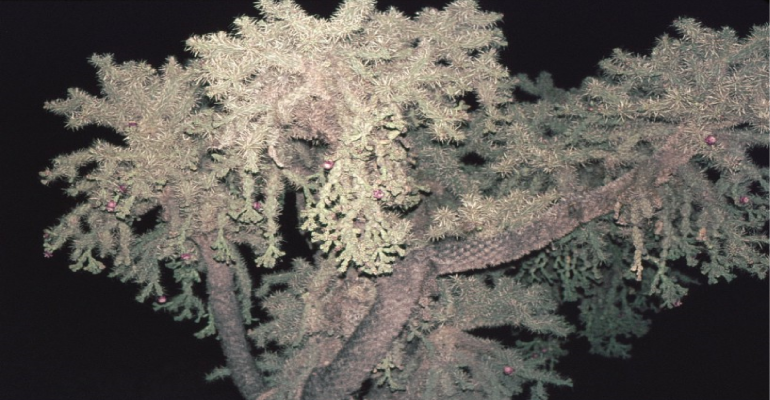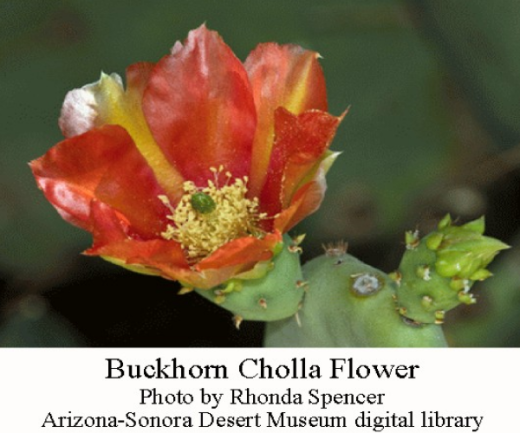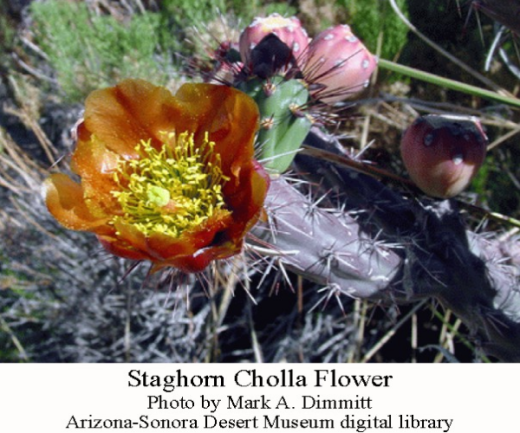
Staghorn cholla (Opuntia versicolor) and buckhorn cholla (Opuntia acanthocarpa) often occur together and have a similar appearance. Much to the consternation of botanists, they often form hybrids with each other, some with sterile seeds, some with fertile seeds.
Both chollas have thin branches that arise from the ground or from a short trunk. Buckhorn chollas are generally around three feet tall, but can grow to 13 feet tall. Staghorn cholla also range usually from three to eight feet tall, but can get more than 15 feet tall. The staghorn in the photo I took was at least 15 feet tall. The lighting made it look like an alien from outer space.
In general, buckhorn chollas are found in central and western Arizona and northern Sonora up to an elevation of 4,000 feet. Staghorn cholla occurs in Pinal and Pima Counties, Arizona, and in northern Sonora. In the Tucson area, it occurs usually between 2,000 and 3,000 feet elevation.
 Both species have stems that may be tinged with red or purple, especially in winter. Both species have variable flower colors. The main colors are red or yellow, but flowers can also be orange, pink, purple, green, or brown. Flowers on individual plants are usually all the same color but individuals with different flower colors can occur in the same population. See more photos of the buckhorn and staghorn from the Arizona-Sonora Desert Museum digital library.
Both species have stems that may be tinged with red or purple, especially in winter. Both species have variable flower colors. The main colors are red or yellow, but flowers can also be orange, pink, purple, green, or brown. Flowers on individual plants are usually all the same color but individuals with different flower colors can occur in the same population. See more photos of the buckhorn and staghorn from the Arizona-Sonora Desert Museum digital library.
According to the Arizona-Sonora Desert Museum (ASDM):
“The fruits provide the best way to distinguish the two species when they are not in bloom. At maturity, the fruit of the buckhorn cholla is dry, deeply tuberculate, and covered with long, barbed spines. Fruits fall off after several months. Staghorn cholla fruit is fleshy at maturity, turgid, usually spineless, and persists on the plant for more than a year.”
ASDM also notes:
 “Besides the variability of flower color, buckhorn cholla is extremely variable in vegetative characters, such as plant height and branching angle, color, number and size of spines, and size and shape of tubercles. Taxonomists have distinguished four varieties, and almost every mountain range and valley has a different-looking population.”
“Besides the variability of flower color, buckhorn cholla is extremely variable in vegetative characters, such as plant height and branching angle, color, number and size of spines, and size and shape of tubercles. Taxonomists have distinguished four varieties, and almost every mountain range and valley has a different-looking population.”
All cactus fruit is edible, but apparently cholla fruit does not taste good and is avoided by desert animals. However, native people collected the flower buds of the Buckhorn, Staghorn, and Pencil cholla and prepared them by steaming. The taste, to me, is similar to asparagus.
See more ADI articles on desert plants:
Agaves provide food, fiber and adult beverages
Arizona Christmas Cactus – the Pencil cholla
Cactus water will make you sick
Chiltepin peppers, spice and medicine
Desert Broom – another medicinal plant
Desert Tobacco, a Pretty but Poisonous Desert Plant
Devil’s Claw provides food, fiber and medicine
Guayacán a pretty flowering tree
Invasion of the Popcorn Flowers
Joshua Trees of the Mohave Desert
Medusa’s Head a strange and useful plant
Mesquite trees provide food, fuel, medicine, and more
Oak trees of the Sonoran Desert region
Ocotillo – an aide to hummingbirds and geologists
Palo brea trees and their uses
Palo Verde trees about to turn the desert golden
Sacred Datura – pretty, poisonous, and hallucinogenic
Saguaro Cactus Icon of the Sonoran Desert
Spectacular flowers of the red Torch Cactus
